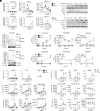Glucocorticoids regulate lipid mediator networks by reciprocal modulation of 15-lipoxygenase isoforms affecting inflammation resolution
- PMID: 37603745
- PMCID: PMC10469032
- DOI: 10.1073/pnas.2302070120
Glucocorticoids regulate lipid mediator networks by reciprocal modulation of 15-lipoxygenase isoforms affecting inflammation resolution
Abstract
Glucocorticoids (GC) are potent anti-inflammatory agents, broadly used to treat acute and chronic inflammatory diseases, e.g., critically ill COVID-19 patients or patients with chronic inflammatory bowel diseases. GC not only limit inflammation but also promote its resolution although the underlying mechanisms are obscure. Here, we reveal reciprocal regulation of 15-lipoxygenase (LOX) isoform expression in human monocyte/macrophage lineages by GC with respective consequences for the biosynthesis of specialized proresolving mediators (SPM) and their 15-LOX-derived monohydroxylated precursors (mono-15-OH). Dexamethasone robustly up-regulated pre-mRNA, mRNA, and protein levels of ALOX15B/15-LOX-2 in blood monocyte-derived macrophage (MDM) phenotypes, causing elevated SPM and mono-15-OH production in inflammatory cell types. In sharp contrast, dexamethasone blocked ALOX15/15-LOX-1 expression and impaired SPM formation in proresolving M2-MDM. These dexamethasone actions were mimicked by prednisolone and hydrocortisone but not by progesterone, and they were counteracted by the GC receptor (GR) antagonist RU486. Chromatin immunoprecipitation (ChIP) assays revealed robust GR recruitment to a putative enhancer region within intron 3 of the ALOX15B gene but not to the transcription start site. Knockdown of 15-LOX-2 in M1-MDM abolished GC-induced SPM formation and mono-15-OH production. Finally, ALOX15B/15-LOX-2 upregulation was evident in human monocytes from patients with GC-treated COVID-19 or patients with IBD. Our findings may explain the proresolving GC actions and offer opportunities for optimizing GC pharmacotherapy and proresolving mediator production.
Keywords: glucocorticoid; inflammation; lipid mediators; lipoxygenases.
Conflict of interest statement
The authors declare no competing interest.
Figures





References
-
- Perretti M., D’Acquisto F., Annexin A1 and glucocorticoids as effectors of the resolution of inflammation. Nat. Rev. Immunol. 9, 62–70 (2009). - PubMed
Publication types
MeSH terms
Substances
Grants and funding
LinkOut - more resources
Full Text Sources
Medical
Miscellaneous

